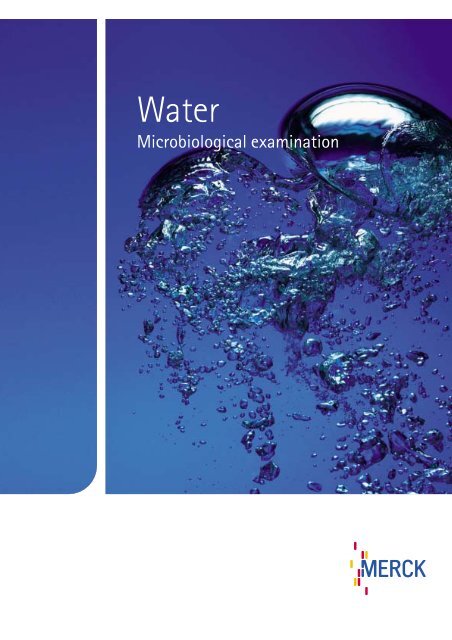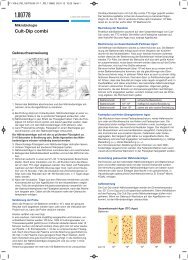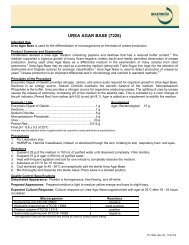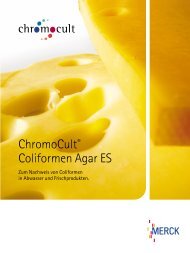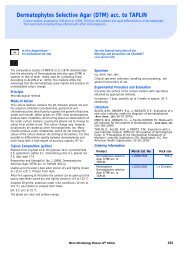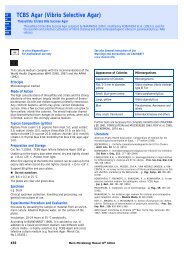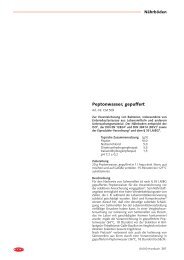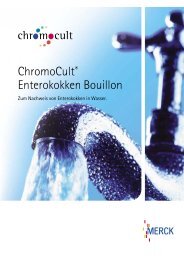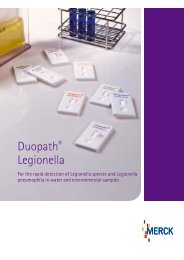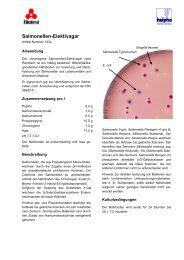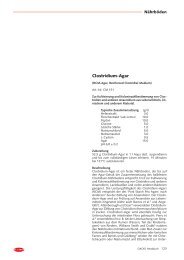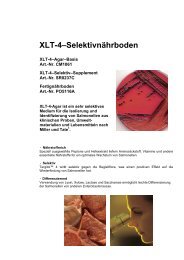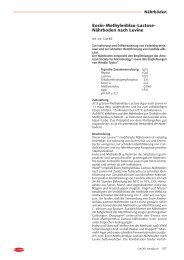Microbiological examination - mibius
Microbiological examination - mibius
Microbiological examination - mibius
Create successful ePaper yourself
Turn your PDF publications into a flip-book with our unique Google optimized e-Paper software.
The availability of clean, freshwater is one of the mostimportant issues facing humanitytoday - and will be increasinglycritical for the future, as growingdemands outstrip supplies andpollution continues to contaminaterivers, lakes and streams."Lack of access to water - fordrinking, hygiene and foodsecurity - inflicts enormoushardship on more than a billionmembers of the human family",said United Nations Secretary-General Kofi Annan. "Water islikely to become a growing sourceof tension and fierce competitionbetween nations, if presenttrends continue, but it can alsobe a catalyst for cooperation.“3
Water borne illnessWater borne infections still ravage the global community and areresponsible for millions of deaths per year. Water that looks clear and puremay be sufficiently contaminated with pathogenic microorganisms to bea health hazard. A prime public health consideration is the continuoussupply of drinking water which is free of pathogens and significant levelsof toxic chemicals. Protection of drinking water from contamination byhuman or other animal excrement in sewage, food processing wastes andstorm water run off is of paramount importance.The majority of infections associated with the water cycle are those whichcause gastroenteritidis. The symptoms vary with etiological agent.A variety of etiological agents have been implicated in water borne diseases.The causative agents include: Bacteria, viruses and intestinal parasites.The causative agent varies with the geographical area climate, general levelof sanitation, endemic persistence, as well as cultural and socio-economiccharacteristics of the population.It is well established that unsatisfactory water supplies are related to illhealth. Water contamination occurs generally due to seepage of sewageor surface contaminated water in aquifers and improperly protected wells,or is due to inadequately treated or distributed drinking water. Personto person contact has been documented in the transmission of Legionellato humans. Legionella is a common inhabitant of natural waters. Thedirect way of transmission is the inhalation of contaminated aerosolizedcontaminated water.4
Some pathogens that may occurin drinking water:Bacteria• Vibrio cholerae• Shigella dysentriae• Enterotoxigenic Escherichia coli• Salmonella spp. (e.g. Salmonella typhi)• Campylobacter jejuni• Aeromonas hydrophila• Pseudomonas aeruginosa• Legionella• Yersinia enterocoliticaViruses• Enterovirus• Poliovirus• Coxsackievirus• Echovirus• Reovirus Adenovirus• Hepatitius A virus, Norwalk like virus, Astro virus• Calcivirus, Epidemic non A, non B hepatitusIntestinal parasites• Cryptosporidium• Giardia• Entamoeba histolytica5
<strong>Microbiological</strong>monitoring of waterWater systems should be monitored at a frequency that is sufficient toensure that the system is under control and continues to produce water ofan acceptable quality. Samples should be taken from representativelocations within the processing and distribution system. Established samplingfrequencies should be based on system validation data and covercritical areas.The sampling plan should take into consideration the desired attributes ofthe water being sampled. Sampling ports should be sanitized andthoroughly flushed before a sample is taken. Samples containing chemicalsanitizing agents require neutralisation prior to microbiological analysis.<strong>Microbiological</strong> <strong>examination</strong> of drinking water is an attempt to determinethe relation of the possible transmission of water borne disease. It isusually not practical to examine water supplies for the various pathogensthat may be present. Therefore, the routine monitoring of water is basedon the testing of indicator organisms.Reliance on waterquality determinationalone is insufficient toprotect public health.It is neither physicallynor economicallyfeasible to test for alldrinking water qualityparameters equally.Therefore monitoringefforts and resourcesshould be carefullyplanned and directed atsignificant or keycharacteristics.Samples for microbiological analysis should be tested immediately.If this is not possible, samples should be protected (in line with local regulations/guidelines)to preserve them until they can be analysed.6
Heterotrophic Plate CountThe Heterotrophic Plate Count (Total Viable Count) is part of the routinemonitoring of drinking water, which includes water in closed containers,mineral water and general application to the monitoring of all water types.Heterotrophic counts are also employed in the testing of water used in thepreparation of food and drinks.The Heterotrophic Plate Count (HPC/TVC) was formerly termed standard platecount or “total” plate count. HPC gives an indication of the integrity of groundwater sources, the efficacy of water treatment processes, the cleanliness, theintegrity of the water distribution system by measuring the re-growth or theafter-growth-potential in treated drinking water.Microorganisms will normally grow in water and also as biofilms on surfacesin contact with water. Growth following drinking water treatment is normallyreferred to as re-growth. Growth is typically reflected in higher HPC/TVC valuesmeasured in water samples.HPC/TVC indicates the effectiveness of water treatment processes, thus it is anindirect indication of pathogen removal and a measure of the numbers of regrowthorganisms that may or may not have sanitary significance. In long termroutine monitoring, a deviation from the common heterotrophic colony countssignals changes in the microbial water quality. A sudden raise in the HPC givesan early warning of pollution and calls for immediate investigation.The consumption of, or exposure to water containing large numbers ofHPC/TVC organisms can lead to diseases, such as gastroenteritis, skin andmucous membrane infections, particularly in people whose immune systemis already compromised. Opportunistic pathogens are naturally present inthe environment and can be found in source water and treated drinking water.The heterotrophic plate count bacteria identified as opportunistic pathogensinclude: Acinetobacter, Aeromonas, Flavobacterium, Klebsiella, Legionella,Moraxella, Mycobacterium, Serratia, Pseudomonas and Xanthomonas.Heterotrophic Plate Count bacteria require simple organic carbon rather thancarbon dioxide for growth. HPCs vary with media composition, time ofincubation, temperature of incubation and inoculation method (pour or surfaceplating). Heterotrophic counts are generally conducted at both 22°C and35-37°C (see local regulations/guidelines).Total coliform countTotal coliform count is used as indicator of the general sanitary quality of treateddrinking water supplies. The term coliform bacteria represents a vaguely definedgroup of organisms which have a long history in water quality assessment.Coliform bacteria are aerobic and facultative anaerobic, Gram-negative, nonsporeforming bacilli. They ferment lactose, produce gas within 24h at 35°C.The enzyme ß-galactosidase is present in 94-96% of the coliform bacteria.7
Coliform bacteria occur in the bowel of humans and warm-blooded animals,but also in soil and fresh surface water. Although many of these bacteria are offaecal origin, some are heterotrophic and able to multiply in various waterenvironments. The presence of coliform bacteria is not always proof of faecalcontamination. The presence in drinking water is usually a result of a problemwith the treatment system or water pipes and indicates that the water maybe contaminated with microorganisms that can cause disease. Coliform bacteriaare detected by incubation of selective broths or plating agars at 35-37°C.Faecal or thermotolerant coliform bacteriaFaecal coliform bacteria are bacteria that are associated with human or animalwastes as they usually live in human or animal intestinal tracts. Their presencein drinking water is a strong indication of recent sewage or animal wastecontamination.Faecal coliform bacteria are predominantly Escherichia coli and thermotolerantstrains of Klebsiella.The group of faecal or thermotolerant coliform bacteria is more closely relatedwith faecal pollution than total coliform bacteria. The presence of faecalcoliform bacteria in drinking water is generally not acceptable. The faecal orthermotolerant coliform bacteria are determined by incubation of selective brothsor plating agars at elevated temperature (44 or 45.5°C) using the water bath.Escherichia coliEscherichia coli is a species belonging to the coliform group of bacteria thatnormally inhabits the bowel of humans and warm-blooded animals.The presence of E.coli in water indicates a pollution of faecal origin as result ofrecent sewage or animal waste contamination. E.coli rarely multiplies in waterenvironments.During rainfalls, snowmelts or other types of precipitation, E.coli may be washedinto creeks, rivers, streams, lakes and groundwater. When these waters areused as sources for drinking water and untreated or inadequately treated, E.colimay end up in the drinking water.E.coli is a faecal coliform bacterium that ferments lactose, produces gas at 35°Cand 44°C or 45.5°C (i.e. 90% of E.coli), is Indole-positive (i.e. 99% of E.coli)and characterised by ß-galactosidase and ß-glucuronidase (i.e. 96% of E.coli)activity.E.coli is a thermotolerant coliform that is isolated or enumerated by incubationof selective broths or plating agars at an elevated temperature (44.5 or 45.5°C)using the water bath.Faecal streptococci, intestinal enterococci, other enterococciFormerly, all streptococci of faecal origin i.e. faecal streptococci or intestinalenterococci that produce group D antigen belonged to the group of Lancefield Dstreptococci. Since 1984 the classification of streptococci has been reorganised.8
Streptococcus has been divided in three different genera: Streptococcus,Enterococcus and Lactococcus. The Lancefield D streptococci are grouped in thegenus Enterococcus. S.bovis and S.equinus that belonged to the Lancefield Dstreptococci have been placed in a group of “other” streptococci.Members of the genus Enterococcus are e.g. E.avium, E.casseliflavus, E.durans,E.faecalis, E.faecium , E.gallinarium, E.hirae, E.malodoratus, E.mundtii,E.raffinosus, E.solitarius and E.faecalis (variant). Enterococcus spp. are Grampositive,Catalase-negative cocci and usually grow at 45°C in 6.5% NaCl andpH 9.6.The species E.faecalis, E.faecium, E.durans and E.hirae occur frequently infaeces of humans and homeothermic animal’s. Enterococcus spp. like E.avium,E.cecorum, E.columbae and E.gallinarium are of other faecal origin and occurrarely in environmental samples. It should be noted that some enterococcie.g. E.casseliflavus and E.mundtii are non-faecal species found in water that canalso originate from plant material or some industrial effluents. S.bovis andS.equinus are of “other” faecal origin and occur rarely in environmental samples.Enterococci occur less numerous than faecal coliforms and E.coli in humanfaeces. The low level or infrequent occurrence of enterococci in source waterlimits their use as indicators in drinking-water treatment processes. Enterococcirarely grow in the environment, are more resistant to various treatment anddisinfection processes than coliform bacteria and possibly even coliphages andviruses. In the US, enterococci may be used as indicators when monitoringmarine recreational water samples due to their ability to survive in high concentrationsof salt as compared to E.coli.Enterococci are an indicator of water treatment efficiency. They are oftenemployed as a secondary indicator for resampling after the detection of coliformbacteria or E.coli in distribution systems, as an indicator in the routinemonitoring after new water mains are laid or after repairs to distributionsystems. Enterococci tests are run to get supplementary data on the bacteriologicalquality of natural water systems, because they rarely multiply in water.Clostridia or Clostridium perfringensClostridia and Cl.perfringens are suitable indicators for the survival of virusesand protozoan cysts in drinking water or oocysts in treated drinking water,when sewage is the suspected cause of contamination. The spores are largely offaecal origin and are always present in sewage. Vegetative cells appear not toreproduce in aquatic sediments.Clostridia and Cl.perfringens are not recommended for the routine monitoringof distribution, as they survive and accumulate and may be detected longafter pollution has occurred. The presence of Clostridia and Cl.perfringens intreated water suggests deficiencies in treatment, failure of disinfection processesor recontamination of the treated water.A great advantage of Clostridia when used as indicator organisms is that thedetection methods are relatively simple in comparison to the detection methodsof viruses and cysts and a result is available within 24h. Clostridia spores aremore resistent to disinfection than other pathogens. Particularly Cl.perfringenshas a high specificity for faecal pollution.9
Yeast Extract AgarA medium rich innutrients which permitsthe recovery of a widespectrum of bacteria,yeast and moulds. Thetotal count mediumconforms with ISO 6222 .10
<strong>Microbiological</strong> methodsfor <strong>examination</strong> of waterIn the microbiological <strong>examination</strong> of water there are four different culturalmethods routinely employed and recommended in standards. These include:Aerobic or Heterotrophic Plate Count (HPC), Presence -Absence (P-A) testing,Most Probable Number (MPN) method and Membrane Filtration (MF) method.Heterotrophic Plate Count (HPC)A plate count like the Heterotrophic Plate Count is commonly determined usingthe pour plate technique. 1ml of a water sample or a decimal dilution series istransferred to separate Petri dishes.15ml of liquified agar medium is thenadded to each Petri dish (no stacking of plates when pouring agar). The sampleis thoroughly mixed by rotation (three times left, three times right and oncethrough the centre). The agar is left to solidify (no stacking of plates duringsolidification) on a flat level, preferably cool, surface. After complete solidification(check by ticking the Petri dish on the side; solidification occurs latest inthe centre) the plates are inverted and incubated (BAM requires 48 ±2h at 35°C).Plates showing 25 to 250 colonies (including pinpoint colonies) should beconsidered in determining the standard plate count. A count is designated asstandard plate count at temperature of incubation. The incubation temperaturecan either be 20, 30 or 35-37°C. Depending on incubation temperature andatmosphere, the counts are termed psychrotrophic aerobic or anaerobic standardcount (20°C) or mesophilic aerobic or anaerobic plate counts (30 or 35-37°C).Presence-Absence (P-A) testingThe objective of the Presence-Absence testing is to obtain qualitative informationon the presence and absence of the target organism or group of organisms.For the Presence-Absence test commonly a 100ml sample is transferred to asingle flask. A double (acc. to ISO) or triple strength (acc. to Standard Method)liquid culture medium is then added. The use of a double or triple strengthmedium prevents that the sample dilutes in the culture medium and therebyreduces its selectivity.Most Probable Number or Multiple tube technique (MPN)The Multiple tube testing is a modification of the Presence-Absence testing.Instead of adding the sample to a single tube, the sample is divided in portionsand multiple tubes are inoculated with variable volumes of the same watersample. The reference methods employ different volumes and replicates for theMultiple tube testing. For detailed information please refer to ISO 8199, thegeneral guide to the enumeration of microorganisms by culture or to StandardMethods 21st Edition, Method 9221 “Multiple tube fermentation” therein. Forsample volumes less than 5 ml or 10 ml (Standard Methods) the sample is addedto an equal volume of single strength media. For volumes of 10-100ml, doublePresence-AbsenceBrothSelective medium forthe detection of coliformbacteria in water.The medium conforms withthe recommendations ofStandard Methods for the<strong>examination</strong> of water andwastewater.Lactose fermenting organismsproduce acid whichis identified by the indicatorbromocresol purple with acolor change from purpleto yellow.11
strength media are commonly used. Standard Methods, however, recommendthe use of triple strength media for volumes of 100ml and higher. Moreover,Standard Methods 21st Edition shows a table in Method 9221 for the preparationof Lauryl Sulfate Broth.The positive and negative test results of each tube can be used for a calculationof the estimated number of counts of microorganisms. The Most Probable Number(MPN) is read from the MPN table found in Standard Methods.Membrane Filtration (MF)Membrane Filtration is simpler and yields numerical results quicker than theMultiple tube test. The membrane filter technique is useful in drinking water,but has its limitations when testing waters that are heavily contaminated orhave a high non-coliform background.A1-MediumSelective medium for thedetection of faecalcoliform bacteria in water.The medium conformswith the recommendationsof Standard Methodsfor the <strong>examination</strong> ofwater and wastewater.With no or little experience with the Membrane Filtration technique it is advisedto first run samples using Membrane Filtration in parallel with the more familiarPresence-Absence test.The sample size should be chosen so that the yield on the membrane filterranges from 20-60 colonies (e.g. for faecal Streptococcus/Enterococcus acc. toStandard Methods and acc. to ISO) or 20-80 colonies (e.g. for coliform bacteriaacc. to Standard Methods, EP or USP). The usual sample size is 100ml.Occasionally a larger volume is used: e.g. for the detection of Pseudomonasaeruginosa in natural water (200ml) or up to 500ml for swimming pool waters.The membrane filters commonly used have a mean pore diameter of 0.45mmand about 50mm in total diameter. The type of filter material is chosen so thatthe bacteria retaining efficiency is neither affected by the components of thefilter nor by the components of the sample to be investigated.The Membrane Filtration technique is relatively simple. At the beginning of eachfiltration series, the filtration units are sterilised to avoid contamination. Usingsterile tweezers, a sterile membrane filter is placed over the porous plate ofthe filtration unit, grid side up. The matched funnel unit is carefully placed overthe receptacle and locked in place. A volume of water is then filtered throughthe membrane filter under partial vacuum. The membrane filter retains the organismson the surface. The filter may be rinsed with three 30ml portions of sterilebuffered water or membrane rinsing fluid (EP or USP). It is advised to validatethe number of washes.After the filtration, the funnel is unlocked and removed. The membrane filter isremoved with sterile tweezers and placed on the agar medium with a rollingmotion to avoid the entrapment of air. Agar plates used, should have a visuallydry surface. The agar plate is incubated inverted. After the recommendedincubation period the colonies are counted. The counts of typical colonies on aselective medium are presumptive counts. A confirmation of a square root oftypical colonies gives the confirmative count. Counts are expressed as cfu per mlfor a filtered sample.12
Membrane FiltrationThe type and brand ofmembrane filters can greatlyaffect the recovery ofmicroorganisms as this figureillustrates for the recoveryof coliform bacteria onChromoCult® Coliform Agar.AAThe best performance onChromoCult® Coliform Agar isobtained when usingCellulose-Mixed-Estermaterial e.g. Pall GN-6 orSchleicher and Schuell ME 25(Ossmer et al. 1999).BBCCDDA: Pall GN-6Mixed-EsterB: Whatman 7141114Cellulose-NitrateC: Schleicher & Schuell 405370Cellulose-NitrateD: Schleicher & Schuell 405370Cellulose-Acetate13
Rapid Presence-Absence (P-A) testing andMost Probable Number or Multiple tube technique (MPN)FluoroCult® LMX and Readycult® Coliforms 50 and100FluoroCult® LMX Broth allows the simultaneous testing of total coliformbacteria and E.coli. It contains a fluorogenic substrate and a chromogenic dye.FluoroCult® LMX is US EPA approved as a slight modification of the alreadyEPA approved Readycult® medium (self preparation for FluoroCult® LMX Brothversus ready-to-use snap pack format for Readycult® Coliform).Readycult® Coliforms is the convenient and easy to open snap pack format ofFluoroCult® LMX Broth. It contains pre-weighed sterile granulated FluoroCult®LMX medium and is available as Readycult® Coliform 50 for the preparation of50ml broth or Readycult® Coliform 100, for the preparation of either 100 mlbroth or 50 ml double strength broth.Readycult® Coliforms 50 and 100 allow immediate on site testing. The contentof one snap pack is directly added to the water sample.FluoroCult® LMX and Readycult® Coliforms are convenient and cost-savingapproved methods for testing E.coli and coliforms acc. to the EPA Total ColiformRule. The overall testing time is reduced by 4 days compared to traditional EPAmethods and 3 days compared to the ISO method.Total coliform bacteriaWhen using FluoroCult® LMX Broth with the Presence-Absence or the Multipletube (MPN) method, results of total coliform bacteria are available within24 hours. A positive total coliform test is indicated by a blue-green color. Thiscolor change from yellow to blue-green is the result of the splitting of X-Galby the enzyme ß-galactosidase, which is characteristic for 96-97% of coliformbacteria. A color comparator is not needed to read results in FluoroCult®LMX Broth or Readycult® Coliform. The distinct blue-green color of a positivetest sample is easily distinguished even with colored water samples. FluoroCult®LMX Broth is also much easier and more reliable to read than the traditional gasproduction in inverted (Durham) tubes (Manafi & Rossmann 1999). X-Gal wasproven to be a faster and more sensitive parameter for total coliforms than thegas production from lactose (Ossmer 1993).The FluoroCult® LMX Broth, Readycult® 50 and 100 total coliform methods areas sensitive as the traditional Standard Method or ISO reference methods andeasier to interpret (Betts et al. 1994, Lee et al. 1995, Manafi 1995).Aeromonas constitute a fraction of the heterotrophic population found in drinkingwater. It is well documented that in Colilert-18 aeromonads provoke apositive response (Covert et al. 1989, Landre et al. 1998, Edberg et al. 1998,Katamay 1990, Cowburn et al. 1994). Aeromonas hydrophila is a water bornepathogen that should not be present in finished waters. As with Colilert,A.hydrophila and A.sobria (a fish pathogen) can produce false positive testresults in FluoroCult® LMX Broth and Readycult® Coliforms 50 and 100 (Manafi1995, Manafi & Rossmann 2000).FluoroCult® LMX Broth:A fluorogenic and chromogenicenrichment broth for the simultaneousdetection of coliformbacteria (total coliform testing)and E.coli. A distinct color changefrom yellow to blue green indicatesa positive total coliform test.No need for a color comparator!The medium comes in granulatedform which reduces the healthrisk of inhaling dust particles anddissolves quickly. Results are easyto read and allow cost-cutting,since additional time consumingconfirmation procedures are notneeded.The selectivity of FluoroCult® LMXBroth can be enhanced by theaddition of E.coli/ColiformSelective-Supplement. Cefsulodinprevents the growth ofaeromonads and allows thetesting of non-treated waterwithout the problematicinterference of non coliforms.Readycult® Coliforms:Ready-to-use snap pack containingpre-weighted sterile granulatedFluoroCult® LMX Broth for thepreparation of single (50 or 100ml) ordouble strength (50 ml) media.Readycult® Coliforms is US EPAapproved according to the Total ColiformRule (40 CFR141,21f) and, as oftoday, the only EPA approved methodwhich allows the Indole reactionto be performed directly in the brothto verify the presence of fluorescencepositive confimed E.coli result.15
Escherichia coliWhen using FluoroCult® LMX Broth or Readycult® Coliforms the presence ofE.coli in a positive total coliform sample is indicated by a blue fluorescencewhen exposed to UV light in the dark. A UV lamp with a minimum of 6 wattsand a wavelength of 366nm should be used. Simultaneous blue-green color andfluorescence is a strong indication of the presence of E.coli. It is known(e.g. Manafi,1995) that there are a small number of bacteria other than E.colicapable of producing positive fluorescence. Therefore, an additional reaction,the Indole test, may be used to confirm the presence of E.coli.Indole test:This test using Kovàcs’ reagent has been used for several decades and establishedby microbiologists worldwide as one biochemical reaction on the way to anidentification of bacteria. The test is based on an enzymatic reaction where tryptophanis cleaved (tryptophanase hydrolysis) and transferred into Indole, pyruvicacid and ammonia. The presence of Indole is detected with Kovàcs’ reagent andindicated by a cherry red color. 99% of E.coli are Indole-positive.FluoroCult® LMX Broth and Readycult® Coliforms allow this Indole reactionto be performed directly in the broth, meaning the presence of E.coli is confirmedwithin 24 hours! False positive fluorescing samples are easily detected!Kovàcs’ reagents is added to an aliquot from a fluorescence (MUG) positivesample (shake the sample prior to taking the aliquot). When using the reagent,a red ring, confirms the presence of E.coli.E.coli 0157ß-D-glucuronidase is used as an indicator for E.coli. Other Escherichia spp. donot produce this enzyme (Rice et al. 1991). Some pathogenic strains of E.coli suchas typical E.coli 0157:H7 however do not posses ß-D-glucuronidase either(Frampton and Restaino, 1993). So, these pathogenic strains do not show positivefluorescence, however, they do produce a positive Indole reaction. When usingFluoroCult® LMX Broth or Readycult® Coliforms, blue-green colored samples(total coliform positive) showing no fluorescence (negative MUG reaction) can bechecked for E.coli 0157 using the Indole reaction as described above. A positiveIndole reactions in such water samples indicates presumptive E.coli 0157 andfurther tests for confirmation should be performed.E.coli 0157 confirmationThe presence of pathogenic E.coli strains can be confirmed in less than 20minutes by using the new Singlepath® E.coli 0157 lateral flow test (WQTC poster,Philadelphia, November 2003; AOAC approval pending). An aliquot from a bluegreencolored, fluorescence negative and Indole-positive water sample is directlytransferred to the lateral flow test. No further handling step is necessary. Theappearance of red bands at the test “T” level and the control “C” level are consideredpositive for E.coli 0157. A signal only at the control “C” level is considerednegative.ChromoCult® Enterococci BrothThe advantages of FluoroCult® LMX,Readycult® Coliformand ChromoCult® Coliform AgarMore effectiveFasterMore specificEasierEconomicalConvenientEPA approval• Simultaneous detection of totalcoliforms and E.coli• Two confirmed results in one testwithin 24h allows a water municipalityto take corrective actions• Distinct color reaction eases routinereading with high confidence level forpersonnel• ß-galactosidase reaction (99%) ismore specific than gas reaction (95%)and 99% of E.coli’s are Indole -positive, whereas only 90% of E.coli’sproduce gas and acid from lactoseat 44°C• No Durham tube necessary• No further confirmation required• Less false positives• Naturally yellow-colored watersamples are not a problem• Cost reduction, because less materialand less workload in the lab• Readycult® easy-to-use snap packformat can be used in the field andincubated during transportation tothe labChromoCult® Coliform Agar is a US EPA approved methodto test drinking water for total coliforms and E.coli usingthe Membrane Filtration method.The advantages of ChromoCult®Enterococci Broth /Agarand Readycult® EnterococciMore specificFasterEconomicalConvenient• Clear color changes• MPN / P-A: generally within 24 h• Membrane Filtration (MF):within 24-48 h• Less false positive results• No further confirmation of faecal(intestinal) streptococci required• Readycult® easy-to-use snap packformat16A selective enrichment medium for thedetection of faecal (intestinal)streptococci/enterococci in water samples.
ChromoCult® Enterococci Broth andReadycult® Enterococci100ChromoCult® Enterococci Broth uses for the suppresion of non enterococcisimilar to Azide Dextrose Broth an azide selective system. ChromoCult®Entero-cocci Broth includes additional the chromogenic substrate X-Glu. Theuse of the X-Glu diagnostic system improves the accuracy and simplifies thereading. The enzyme ß-D glucosidase is characteristic for faecalstreptococci/enterococci and splits the chromogenic substrate X-Glu resultingin a distinct color change from yellow to blue-green. The blue-green color of thebroth confirms largely the presence of faecal streptococci within 24h. S.bovisand S.equines both grow in ChromoCult® Enterococci Broth/ Readycult®Enterococci100 producingthe blue-green color, whereas Aerococcus viridans grows but does not producethe typical blue-green color. Faecal streptococci do not require additionaltesting. The presence of Enterococcus spp. should be verified by confirming thegrowth in Brain Heart Infusion (BHI with 6.5% salt) at 45°C.Membrane Filtration (MF)ChromoCult®Coliform Agaris a selective agar for the simultaneousdetection of total coliformbacteria and E.coli in drinkingwater.E.coli: dark-violetColiform bacteria: pink-redNon-coliforms: colorless or greenChromoCult® Coliform AgarChromoCult® Coliform Agar contains 2 chromogenic substrates, Salmon-Galand X-Glu. The agar allows not only the distinguished differentiation betweentotal coliforms, E.coli and non-coliform bacteria but also the enumeration ofthese organisms within 24 hours.Total coliform bacteriaColiform bacteria appear as pink to red colonies on ChromoCult® Coliform Agar.The color is the result of the splitting of Salmon-Gal by ß-D-galactosidase, anenzyme, which is produced by coliform bacteria.Escherichia coliE.coli bacteria appear as dark violet colonies on ChromoCult® Coliform Agar.This color is the result of the splitting of Salmon-Gal by ß-D galactosidase andX-Glu by ß-D-glucuronidase, which is produced by E.coli. Further confirmationof typical E.coli colonies can be achieved by the addition of a dropof Kovàcs’ reagent to the dark pink colonies. This Indole reaction produces a redhalo around the dark violet colonies. It has been shown that the ChromoCult®Coliform Agar performs better than other commercial products and the traditionalStandard Methods (Manafi & Rosman 1999, Lee et al.1995).ChromoCult® Enterococci AgarTo test for faecal streptococci (intestinal enterococci)/Enterococcus, Chromocult®Enterococci Agar contains a mixture of chromogenic substrates. The selectivesystem is an azide selective system, similar to that of Slanetz and BartleyAgar and m-Enterococcus Agar for streptococci. The splitting of the chromogenicsubstrates by enzymes that characterize enterococci results in red colonieswhich are easily distinguished from the blue-violet or turquoise colored coloniesof non-enterococci colonies like Aerococcus spp. The ChromoCult® EnterococciAgar is more specific than most non chromogenic streptococci/enterococciagars as e.g. Aerococcus and S.dysgalactiae produce typical colonies on KAAagar but do not produce typical red colonies on ChromoCult® Enterococci Agar.ChromoCult®Enterococci Agaris a selective agar for the detectionof faecal (intestinal) streptococci/enterococci in water samples.Faecal (intestinal) streptococci/enterococci: redAerococcus spp.: blue17
Merck´s culture mediaMerck has more than 100 years of experience as a manufacturer ofproducts for culturing microorganisms. Already in 1878 Merck producedpeptones that were initially used as food supplements. In 1885 Merckstarted to sell peptones, gelatine, agar-agar specifically for culturingmicroorganisms and began in 1892 to manufacture peptones on industrialscale specifically for culture media preparation.Merck is a pharmaceutical company and this is unique in culture mediamanufacturing. Merck started in1910 with the manufacturing of dehydratedculture media and is the oldest manufacturer of this product. Afterhaving identified the hazards of working with powdered culture media,Merck pioneered as early as 1950s the manufacturing of granulatedculture media and is until now the only manufacturer. Merck takes greatcare to ensure the quality of its products and the service to its customers.Merck laboratory products for microbiology have always set the higheststandards for quality. Our reliability is the result of painstaking qualitycontrol. Merck’s internal laboratories involved in pharmaceutical, chemical,analytical and diagnostic research also keep a watchful eye to ensurethat the quality of Merck’s microbiology products remains flawless.Merck’s customers can rest assured that our products fully comply with allstatutory requirements. Merck gives the assurance, for instance, that onlyTSE low risk substances are used in all our culture media. Laboratorystaff can always refer to certificates of analysis and detailed safety datasheets. In addition, Merck’s sophisticated ChemDat database, accessiblevia the Internet and our Health and Safety data CD-ROM provide an invaluableservice to all our customers.As one of the global market leaders in analytical reagents, Merck is acompany whose products are found in virtually all of the world’s scientificlaboratories. Merck’s innovative strength stems from a thorough knowledgeof the market and of product applications but it is also its closecooperation with the customers that guarantees special user-targetedfeatures in the new products. Merck undertakes everything itself: researchand development, manufacture and also supply of complete productranges of culture media and tests for microbiology, food and environmentalanalysis and hygiene monitoring.18
Safety• All culture media are manufactured from TSE (BSE) -“low risk” ingredients• Certificates of suitability obtained for all animal based materials• All culture media comply with the recommendationes of EDQM and theEuropean Pharmacopoeia• The granular form reduces the exposure to powder and hazardous/toxicchemicalsQuality standards• Culture media manufactured by a pharmaceutical company• Culture media with the highest quality of peptones• A batch to batch consistent high performance• Culture media quality controlled acc. to ISO 11133• Clear and meaningful Certifications of Analysis• A pharmaceutical Regulatory Documentation supportEconomical aspects• Cost saving, because granulation allows the incorporation of selectivecomponents in the dehydrated base medium: fewer purchase ofadditional supplements• Large batches and longer shelf life reduce cost on quality controlConvenience• Ease of handling due to no sticking and quick dissolution of the granulesService• Safety data sheets obtainable via Chemdat online, www.chemdat.info,or on CD-ROM• Certificates of Analysis obtainable via internet www.merck.de• Batch specific TSE (BSE) certificates• Brochures with technical information19
Rapid testingmethodsThe introduction of fluorogenic and chromogenic culture media hasshortened the time to test results by days. The protocols includingFluoroCult® LMX / Readycult® Coliform and chromogenic culture media,like ChromoCult® Coliform Agar and Enterococci Broth media, are rapidcultural testing methods.The use of combinations of different chromogenic substrates orfluorogenic and chromogenic substrates allows the simultaneous testingof different microorganisms or groups of microorganisms.FluoroCult® LMX Broth and ChromoCult® Coliform Agar are approved bythe Environmental Protection Agency (EPA) for the simultaneous detectionof coliform bacteria and Escherichia coli.20
Membrane Filtration (MF)US EPA approved Method* Total coliforms and Escherichia coli Page 22Chromogenic Method Faecal streptococci and enterococci Page 23Presence-Absence /Multiple tube test (P-A /MPN)US EPA approved Method* Total coliforms Page 24Chromogenic Method Faecal streptococci and enterococci Page 25* Method is approved by Environmental Protection Agency (EPA) for monitoringof drinking water quality in accordance with Standard Method 922321
Chromogenic MethodChromoCult® Enterococci AgarDetection and enumeration of faecal streptococci 1 and Enterococcus spp.MFSample size resulting to 20-60 cfu per filterFilter up to 100ml waterMembrane Filtrationday 1Preparation• Transfer membrane filter to ChromoCult®Enterococci Agar• Incubate at 36 ±1°C for 24 - 44 ±4hPositive onChromoCult® Enterococci Agarday 2-3DetectionCount all raised red-maroonor pink typical colonies as enterococci /faecal streptococciConfirmed result: Enterococcus spp.Product list1 Intestinal enterococciCulture medium / Reagent Merck Cat.No. StageChromoCult® Enterococci Agar 1.00950.0500 Detectionday 2-3Confirmation23
US EPA approved 1 acc. to Standard Method 9223P-A/ MPNReadyCult® Coliforms 100 1 and FluoroCult® LMX Broth 1Detection and enumeration of coliform bacteria andEscherichia coli in drinking waterPrep.Sample(e.g. 1 x 100ml or 5 x 20ml or 10 x 10ml)• Add sample to equal volumeof Readycult®/FluoroCult® LMX Broth(100ml sample to 100ml triple strengthand 10ml to 10ml double strength)• Incubate at 36 ±1°C for 24hDetectionday 1Positive reaction inReadycult®/FluoroCult® LMX BrothConfirmed result: ColiformsColoration from yellow to blue greendenotes coliforms presentConfirmationday 2Confirmed result: E.coli• Blue green color and• Fluorescence (365-366nm)Optional:Verified result: E.coliVerificationday 2• Blue green color and• Fluorescence (365-366nm) and• Positive Kovàcs - orBactident® Indole testgives a verified E.coli resultProduct listStage Culture medium / Reagent Merck Cat.No.Detection ReadyCult® Coliforms 50 1.01295.0001ReadyCult® Coliforms 100 1.01298.0001FluoroCult® LMX Broth modified according to Manafi and Ossmer 1 1.10620.0500Verification Kovàcs’ indole reagent 1.09293.0100Bactident® Indole 1.11350.00011 USEPA: 40 CFR Part 141 (Sec. 141.21) Federal Register/Vol. 67, No. 209, Tuesday, October 29, 2002/Rules and Regulations24
Chromogenic MethodReadyCult® Enterococci 100 and ChromoCult® Enterococci BrothDetection and enumeration of faecal streptococci 1 andEnterococcus spp. in drinking waterP-A/MPNSample(e.g. 1 x 100ml or 5 x 20ml or 10 x 10ml)• Add sample to equal volumeof Readycult®/ChromoCult® Enterococci Broth(100ml sample to 100ml triple strengthand 10ml to 10ml double strength)• Incubate at 36 ±1°C for 24hPositive reaction inReadycult®/ FluoroCult® Enterococci BrothConfirmed Result: Enterococcus spp.Coloration from yellow to blue greenday 2 day 1Detection Prep.Conf.Product listCulture medium / Reagent Merck Cat.No. StageReadycult® Enterococci 100 1.01299.0001 DetectionChromoCult® Enterococci Broth 1.10294.05001 Intestinal enterococci25
ISOInternational Standardisation Organisation (ISO)The International Organisation for Standardisation (ISO) is a networkof the national standards institutes of 147 countries. There is one memberper country, with a Central Secretariat in Geneva, Switzerland, thatcoordinates the system. ISO is a non-governmental organization; itsmembers are not delegations of national governments as this is the casein the United Nations system.International Standards are developed by ISO technical committees (TC)and subcommittees (SC).Most standards require periodic revision and therefore ISO has establishedthe general rule that all ISO standards should be reviewed at intervalsof not more than five years. If required, a revision of a standard can occurearlier.26
Plate Count (TVC)ISO 6222 1999 Enumeration of culturable micro-organisms Page 28Membrane Filtration (MF)ISO 11731 1998- 2 2004 Legionella Page 29ISO 9308 - 1 2000 Coliform bacteria and E.coli Page 31ISO 7899 - 2 2000 Intestinal enterococci Page 32ISO 6461- 2 1996 Sulphite reducing anaerobes (Clostridia) Page 33( DIN EN 26461-2 1993)ISO/WD 6461- 2 2002 Clostridium perfringens Page 34DIN EN 12780 2002 Pseudomonas aeruginosa Page 36Presence-Absence - Multiple tube test (P-A/MPN)ISO 9308 - 2 1990 Thermotolerant coliform bacteria and E.coli Page 38ISO 6461 -1 Sulphite reducing anaerobes (Clostridia) Page 40( DIN EN 26461- 1 1993)27
ISO 6222 1999TVCEnumeration of culturable microorganismsColony Count by inoculation in a Nutrient Agar culture mediumPrep.Detectionday 3-5 day 1-2Sample 1 size 1-2ml• Mix 1-2 ml of sampleor peptone dilutionwith 15-20 mlYeast Extract Agar 1• Incubate at 22 ±2°Cfor 68 ±4hResult : TVCCount colonies on platescontaining 10 to 150 colonies• Mix 1-2ml of sampleor peptone dilutionwith 15-20mlYeast Extract Agar 1• Incubate at 36 ±2°Cfor 44 ±4hProduct listStage ISO 6222 1999 product description MERCK product description Merck Cat.No.Detection Yeast extract agar Yeast extract agar acc. to ISO 6222 1.13116.0500and Swedish Standard SS 028171Dilution Peptone diluent (ISO 8199) Peptone from casein, pancreatically digested, granulated 1.07213.1000/2500Other products for enumeration of culturable microorganismsStage ISO or DEV product description MERCK product description Merck Cat.No.Detection Deutsches Einheitsverfahren DEV nutrient agar 1.11471.0500/5000Merckoplate® DEV-Nutrient agar 1.00075.0020DEV gelatin agar 1.10685.0500Dilution Peptone water (1 %) Peptone water (buffered); acc. to ISO 6579 1.07228.0500Peptone diluent (1 %) Peptone from casein, pancreatically digested, granulated 1.07213.1000/2500Peptone saline solution Maximum recovery diluent 1.12535.0500Ringer’s solution RINGER tablets 1.15525.0001Phosphate buffer solution Potassium dihydrogen phosphate (ISO,Reag. Ph Eur) 2 1.04873.0250/1000/5000Magnesium chloride 2 8.14733.0100/05001 Sampling acc. to ISO 5667-1, 2 and 3; Sample preparation, dilution and inoculation acc. to ISO 8199, 5667-3 and 68872 For preparation of phosphate buffer solution28
ISO 11731 1998- 2 2004 1Detection and enumeration of LegionellaMFSample size 1l(in presence of biocide add inactivating agent)Low countMembrane FiltrationCentrifugation(6000g for 10 min. or3000g for 30 min.)High count• Direct platingif sample contains> 10 5 Legionella 2 cfu/ml• Dilution in Pages saline orRingers, if samples containhigh cfu non LegionellaWithout treatment 3Heat treatment 3 Acid treatment 3,41 ± 0.5 ml of sampleat 50 °C for 30 ± 2 min.1 - 10 ml of sample• Centrifuged (6000gfor 10 min. or 3000gfor 30 min.)• Remove half ofsupernatans volume• Add acid buffer andresuspend• Let stand 5 +0.5 min.day 1Preparation•• Spread Surface plate 0.1- 0.1- 0.5 0.5 ml ml on to GVPC Agar 5• Incubate on to GVPC at 36 Agar ± 1°C 3 and read plates after 2, 4, 10d• Incubate at 36 ± 1°Cfor up to 10 dPresumptive result: Legionella• Examine 6 for at least three occasions at 2d intervals plates with binocular microscope• Count each colony with an entire edge and typical ground glass appearance and colored:white-grey-blue-purple, brown, pink, lime green or deep redday 2ConfirmationDetection• Select three 7 colonies characteristic of Legionella• Subculture each onto BYCE and BCYE-cys 8 (alternative to BCYE is Nutrient Agar or Blood Agar)• Incubate at 36 ± 1°C for 48hConfirmed result: LegionellaLegionella are colonies that grow on BCYE but fail to grow on BCYE-cys 9day 3-5Confirmation1 New ISO 11731-2 First Edition 2004-05-01 Detection and Enumeration of Legionella – Direct Membrane Filtration Method for waters with lowbacterial counts. Following foot notes 2-8 concern changes to ISO 11731-2 2004: 2 > 2 x 10 4 cfu/ml; 3 > Membrane Filtration of 10-1000mlafter filtration add 20ml of acid buffer on top of membrane and leave for 5 min., remove buffer by filtration and wash with 10 ml sterile water;4 5 6 Each sample is further handled via Without treatment, Heat treatment and Acid treatment; or BCYE Agar; Examine with binocular microscope;7 8 9 At least five colonies; L.oakrigenesis and L.spiritensis require L-cysteine and iron; If Legionella spp. or serogroups are to be reported useat least 3 colonies for identification by serology, immuno assay or chromatographyProduct list Next page 3029
Product list: ISO 11731 1998Stage ISO 11731 1998 and ISO 11731-2 2004 MERCK product description Merck Cat.No.product descriptionDetection Buffered Charcoal Yeast extract Agar Base Medium (BCYE) Legionella Combi-Pack for the preparation 1.10425.0001Buffered Charcoal Yeast extract Agar Base Medium of 6 x 500 mlwith selective supplements (GVPC Medium) Legionella-GVPC-Selective-AgarBuffered Charcoal Yeast extract Agar Base Medium (BCYE) Merckoplate® Legionella BCYE agar 1.10097.0020Buffered Charcoal Yeast extract Agar Base Medium Merckoplate® Legionella GVPC-selective agar 1.10097.0020with selective supplements (GVPC Medium)Buffered Charcoal Yeast extract Agar Base Medium (BCYE) Legionella CYE Agar Base 1.10242.0500Buffered Charcoal Yeast extract Agar Base Medium Legionella GVPC selective supplement 1.10241.0001with selective supplements (GVPC Medium) Legionella BCYE a-growth supplement 1.10240.0001Confirmation BCYE-Cys - -Dilution Diluted Ringer’s solution RINGER tablets 1 1.15525.0001Phosphate buffered saline Potassium dihydrogen phosphate (ISO,Reag. Ph Eur) 1.04873.0250/1000/5000di-Sodium hydrogen phosphate (ACS,Reag. Ph Eur) 1.06586.0500/2500Sodium chloride (ACS,ISO,Reag. Ph Eur) 1.06404.0500/1000/5000Potassium chloride (GR for analysis) 1.04936.0500/1000/5000Pages saline Potassium dihydrogen phosphate (ISO,Reag. Ph Eur) 1.04873.0250/1000/5000Magnesium chloride 8.14733.0100/0500Calcium chloride dihydrate (ACS,Reag. Ph Eur) 1.02382.0250/0500/5000di-Sodium hydrogen phosphate (ACS,Reag. Ph Eur) 1.06586.0500/2500Sodium chloride (ACS,ISO,Reag. Ph Eur) 1.06404.0500/1000/5000Formol saline - -1 To prepare 1:10 dilution of Ringers solution quarter strengthProduct list: ISO 9308-1 2000Stage ISO 9308-1 2000 product description MERCK product description Merck Cat.No.Detection Lactose TTC agar with sodium Lactose TTC Agar with Tergitol® 7 1.07680.0500heptadecylsulfate Merckoplate® Lactose TTC Agar with Tergitol® 7 1.00074.0020Tryptophan broth DEV tryptophan broth 1.10694.0500Tryptone soy agar Tryptic soy agar (USP) 1.05458.0500Tryptone Bile Agar Chromocult® TBX (Tryptone Bile X-glucuronide) Agar 1.16122.0500Confirmation Kovacs‘ reagent for indole test KOVACS' indole reagent 1.09293.0100Bactident® Indole 1.11350.0001Oxidase reagent Bactident® Oxidase 1.13300.0001Products for dilutionStage ISO product description MERCK product description Merck Cat.No.Dilution Peptone water, buffered (1%) Peptone water (buffered); acc. to ISO 6579 1.07228.0500Peptone diluent (1%) Peptone from casein, pancreatically digested, granulated 1.07213.1000/2500Peptone saline solution Maximum recovery diluent 1.12535.0500Ringer’s solution RINGER tablets 1.15525.0001Phosphate buffer solution Potassium dihydrogen phosphate (ISO,Reag. Ph Eur) 2 1.04873.0250/1000/5000Magnesium chloride 2 8.14733.0100/0500a1Sampling acc. to ISO 5667-1, 2 and 3; Sample preparation, filter, dilution and inoculation acc. to ISO 8199, 6887-1302For preparation of Phosphate buffer solution
ISO 9308 -1 2000Detection and enumeration of Escherichia coliand coliform bacteriaMFSample 1 size 100ml or more (e.g. 250ml for bottled water)resulting to 20-80 cfu per filterMembrane Filtration 1day 1PreparationStandard testRapid test (optional)• Transfer membranefilter to Lactose TTC Agarwith Tergitol® 7• Incubate at 36 ±2°Cfor 21 ±3hif negative reincubateto 44 ±4h• Transfer membranefilter to Tryptic SoyAgar (TSA)• Incubate at 36 ±2°Cfor 4-5hPositive on Lactose TTCAgar with Tergitol® 7Presumptiveresult:Coliform bacteriaCount yellowlactose positivecolonies• Transfer membranefilter from TSAto Trypton Bile Agar(TBA)• Incubate at 44 ±0.5°Cfor 19-20hday 2-3DetectionSubculture (> 10 to all) on:• Tryptic Soy Agar (TSA)• Incubate at 36 ±3°Cfor 21 ±3h• Tryptophan Broth• Incubate at 44 ±0.5°Cfor 21 ±3hOxidase testIndole testIndole test (Kovàcs’ reagentand UV irradiation)Confirmed result:Coliform bacteriaCount Oxidase (-)colonies (TSA)as coliform bacteriaConfirmed result:E.coliCount Oxidase (-)and Indole (+)as colonies as E.coliConfirmed result:E.coliCount all Indole (+)as colonies as E.coliday 4ConfirmationProduct listPrevious page 3031
ISO 7899-2 2000Detection and enumeration of intestinal enterococciMFPreparationday 1Sample 1 size 100mlresulting to 20-80cfu per filterMembrane Filtration 1• Transfer membrane filterto Slanetz and Bartley Agar• Incubate at 36 ±2°C for 44 ±4hPresumptive result:EnterococciDetectionday 3Stop testing,if no typical red-pink coloniesCount red, maroon or pinkcolored typical colonies• Transfer membrane filter to Bile AesculineAzide Agar, pre-heated at 44°C• Incubate at 44 ±0.5°C for 2hConfirmationday 3-4Confirmed result: Intestinal EnterococciCount yellow-brown to black coloniesProduct listStage ISO 7899-2 2000 product description MERCK product description Merck Cat.No.Detection Slanetz and Bartley medium Membrane-filter enterococcus selective agar 1.05289.0500(basal medium)acc. to SLANETZ and BARTLEY (base)Merckoplate® Membrane-filter Enterococcus 1.0076.0020selective agar acc. to SLANETZ and BARTLEYComplete medium Membrane-filter enterococcus selective agar 1.05262.0500(Slanetz and Bartley medium + TTC) acc. to SLANETZ and BARTLEYConfirmation Bile-aesculin-azide-agar Bile aesculin azide agar, acc. to ISO 7899-2 1.00072.0500Merckoplate® Bile-aesculin-azide-agar 1.00077.00201Sampling acc. to ISO 5667-1, 2 and 3; Sample preparation, filter, dilution and inoculation acc. to ISO 8199, 5667-3 and 6887-132
ISO 6461-2 1986 DIN EN 26461: 1993-2Detection and enumeration of the sporesof sulphite-reducing anaerobes (clostridia)MF• Sample 1 size resulting to 20-80cfu per filter• Heat at 75 ±5°C for 15 min.Membrane 1 FiltrationTransfer membrane filter• to Nutrient Agar with sulphiteand iron (II) sulphate or• to Tryptose Sulphite Agar• Incubate at 37 ±2°C for 20 ±4 and 44 ±4hAnaerobic conditionsConfirmed result:Sulphite reducing clostridiaCount typical white colonieswith black haloday 2-3 day 1PreparationDetectionProduct listISO 6461-2 1986 product description MERCK product description Merck Cat.No. StageTryptose sulfite agar Tryptose sulfite cycloserine agar (base) 1.11972.0500 DetectionMerckoplate® TSC Agar 1.00078.0020Sulfite iron agar Standard II nutrient agar 1.07883.0500Sodium sulfite (Ph Eur, BP, E 221) 1.06652.1000Iron (II) sulfate heptahydrate (ACS, ISO, Reag. Ph Eur) 1.03965.0100 /0500Anaerobic incubator Anaerobic jar 2,5 l-volume 1.16387.0001Other products for anaerobic incubationISO 6461-2 1986 product description MERCK product description Merck Cat.No. StageAnaerobiosis Anaerocult® A for microbiology (Reagent for the 1.13829.0001 Detectiongeneration of ananaerobic medium in anaerobic jars)Anaerocult® A mini Gas generating system for the incu- 1.01611.0001bation of one to four petri dishes in an anaerobic atmosphereAnaerocult® P for microbiology for generating 1.13807.0001an anaerobic atmosphere in the single Petri dishPetri-dish rack for up to 12 petri dishes 1.07040.0001Anaeroclip® 1.14226.0001Anaerotest® 1.15112.00011Sampling acc. to ISO 5667-1, 2 and 3; Sample preparation, filter, dilution and inoculation acc. to ISO 8199, 5667-3 and 6887-133
ISO/WD 6461 - 2 2002Detection and enumeration of Clostridium perfringensMF• Sample 1 sizeresulting to 20-80cfu per filter• For potable water 100 mlHeat at 60 ±2°C for 15 ±1min.Preparationday 1Membrane Filtration 1Detectionday 2• Transfer membrane filter to TryptoseSulphite Cycloserine Agarwithout egg yolk (TSC Agar) or m-CP Agar 2• Incubate at 44 ±1°C for 21 ±3hAnaerobic conditionsPresumptive result:Clostridium perfringensCount all black colonies• Subculture (>10 or all) typical well isolated colonies to two plates of Columbia Blood Agar• Incubate at 36 ±2°C for 21 ±3h one plate aerobically and one plate anaerobicallyNitrate-Motility test:• Inoculate Buffered Nitrate-Motility Medium• Incubate at 36 ±2°C for 21 ±3hAcid-Gelatin liquification:• Inoculate Lactose Gelatin Medium• Incubate at 36 ±2°C for 21 ±3hConfirmed result: Clostridium perfringensConfirmationday 3-4Count black colonies that• are non-motile• reduce nitrate to nitrite• produce acid from lactose• liquefy gelatin within 44 ±4 h34
Product listISO 6461-2 2002 product description MERCK product description Merck Cat.No. StageTryptose sulfite cycloserine agar Tryptose sulfite cycloserine agar (base) 1.11972.0500 Detectionwithout egg yolk Merckoplate® TSC Agar 1.0078.0020Buffered nitrate motility medium - - ConfirmationBlood agar (with 5% horse blood) Columbia agar base 1.10455.0500/5000Lactose Gelatin Medium DEV nutrient gelatin 3 1.10691.0500Nutrient gelatin 3 1.04069.0500Lactose monohydrate 3 1.07657.1000/5000Phenol red (ACS) 3 1.07241.0005/0025/0100Nitrate reagent A and B Griess-Ilosvay's reagent 1.09023.0500for detection of nitriteAnaerobic conditions Anaerobic jar 2,5 l-volume 1.16387.0001Other products for anaerobic incubationISO 6461-2 1986 product description MERCK product description Merck Cat.No. StageAnaerobiosis Anaerocult® A for microbiology (Reagent for the 1.13829.0001 Detectiongeneration of ananaerobic medium in anaerobic jars)Anaerocult® A mini gas generating system for the incu- 1.01611.0001bation of one to four petri dishes in an anaerobic atmosphereAnaerocult® P for microbiology for generating 1.13807.0001an anaerobic atmosphere in the single Petri dishPetri-dish rack for up to 12 petri dishes 1.07040.0001Anaeroclip® 1.14226.0001Anaerotest® 1.15112.00011 Sampling acc. to ISO 5667-1, 2 and 3; Sample preparation, filter, dilution and inoculation acc. to ISO 8199, 5667-3 and 6887-12 In accordance with 98/83/EC Annex III3 Merck product is termed DEV Gelatin to which 10g Lactose (Cat.No. 1.07657.1000) and 12.5ml phenol red (0.4%) w/v Solution (Cat.No. 1.11748.0005) is added4 m-CP-Agar acc. to 98/83/EC Annex III is not available from Merck KGaA35
DIN EN 12780 2002Detection and enumeration of Pseudomonas aeruginosaMFSample 1 size to give 20 - 80cfu per filterPreparationday 1Membrane Filtration 1• Transfer membrane filter to Pseudomona Selective (CN Agar)• Incubate at 36 ±2°C for 44 ±4hPyocianinformingcoloniesFluorescent coloniesPresumptive result:Pseudomona aeruginosaRed brown coloniesPresumptive result:Pseudomona aeruginosaDetectionday 2-3Count fluorescent nonblue green (pyocyanin)coloniesCount non fluorescentor red brown coloniesConfirmed result:Pseudomona aeruginosaCount colonies that• are fluorescentwith blue green(pyocyanin) pigment• Transfer isolates toAcetamide Broth• Incubate at 36 ±2°Cfor 44 ±4hConfirmed result:Pseudomona aeruginosa• Pure culturered brown colonieson Nutrient Agar• Incubate at 36 ±2°Cfor 22 ±2hOxidase testConfirmationday 4-9Count colonies that• are fluorescentwithoutblue green pigment• produce ammoniain Acetamide Broth• Subculture oxidasepositive and red browncolonies on King’s BMedium• Incubate at 36 ±2°Cfor up to 5 daysGo to next page36
• Inoculate fluorescentisolates fromKing´s B Medium inAcetamide Broth• Incubate at 36 ±2°Cfor 22 ±2hConfirmede result:Pseudomona aeruginosaCount red browncolonies that are• Oxidase positive• fluorescent• ammonia positiveday 6-11ConfirmationProduct listDIN EN 12780 2002 product description MERCK product description Merck Cat.No. StagePseudomonas selective agar (CN agar) Pseudomonas Selektivagar (Basis) 1.07620.0500 DetectionPseudomonas CN Selektiv Supplement 1.07624.0001Kings B medium KING agar B base (Dansk Standard) 1.10991.0500 ConfirmationAcetamide nutrient solution - -Nutrient agar Standard II nutrient agar 1.07883.0500Oxidase reagent Bactident® Oxidase 1.13300.0001Nessler's reagent Nessler's reagent 1.09028.0100/05001 Sampling acc. to ISO 5667-1,2 and 3; Sample preparation, filter, dilution, and inoculation acc. to ISO 8199, 5667-3 and 6887-137
ISO 9308 - 2 1990P-A/MPNDetection and enumeration of coliform organisms,thermotolerant coliform organisms and Escherichia coliDetection Prep.day 1-2Sample 1 size 100ml or 50ml, 5x10ml and 10x1ml• Transfer sample to tubes and flask acc. to ISO 8199(Volumes > 5ml to double strength medium) Lactose Broth, Mac Conkey Broth,Minerals modified Glutamate Medium or Lauryl Tryptose (Lactose) Broth• Incubate at 35 or 37 ±0.5°C for 21 ±3h; if negative continue to 48hPresumptive result: ColiformsGrowth (turbidity) and gas in Durham tubesColiformsThermotolerant coliformsStandardFast alternative• Transfer a loopful toBrilliant Green Lactose(Bile) Broth• Incubate at 35 or37 ±0.5°C for 48h• Transfer a loopful to ECMedium (+Durham tube)• Incubate at 44 ±0.5°Cfor 24h• Transfer a loopful toLauryl tryptose mannitolBroth with tryptophan• Incubate at 44 ±0.5°Cfor 24hPresumptive result:ColiformsConfirmed result:Thermotolerant coliformsConfirmed result:Thermotolerant coliformsday 2-4Read gas productionRead gas productionRead gas production• Transfer a loopful toNutrient Agar• Incubate at 37 ±0.5°Cfor 24h• Transfer a loopful toTryptone Water• Incubate at 44 ±0.5°Cfor 24hEscherichia coliday 3-4Indole testIndole testOxidase testOxidase testOxidase testConfirmationday 4-5Confirmed result:ColiformsRead gas productionand Oxidase (-)Confirmed result:Escherichia coliRead gas production and Indole formation38
Product listISO 9308-2 1990 product description MERCK product description Merck Cat.No. StageLactose broth Lactose broth 1.07661.0500 DetectionMacConkey broth MacCONKEY broth 1.05396.0500Lauryl tryptose (lactose) broth Lauryl sulfate broth 1.10266.0500Improved formate lactose glutamate medium DEV glutamate broth 1.10687.0500EC medium EC broth 1.10765.0500 ConfirmationBrilliant green lactose (bile) broth Brilliant green-bile-lactose broth 1.05454.0500/5000Lauryl tryptose mannitol broth with tryptophan - -Nutrient agar Standard II nutrient agar 1.07883.0500Tryptone water Tryptone water 1.10859.0500Kovacs‘ reagent for indole KOVACS' indole reagent 1.09293.0100Bactident® Indole 1.11350.0001Oxidase reagent Bactident® Oxidase 1.13300.0001Ringer’s solution quarter strength RINGER tablets 1.15525.0001 DilutionPeptone diluent 0.1% Peptone from casein, pancreatically digested, granulated 1.07213.1000/2500Peptone saline solution Maximum recovery diluent 1.12535.0500Phosphate buffer solution Potassium dihydrogen phosphate (ISO,Reag. Ph Eur) 1.04873.0250/1000/5000Magnesium chloride 8.14733.0100/05001 Sampling acc. to ISO 5667-1, 2 and 3; Sample preparation, filter, dilution and inoculation acc. to ISO 8199, 5667-3 and 6887-139
ISO 6461-1 DIN EN 26461-1 1993Detection and enumeration of the sporesof sulphite reducing anaerobes (clostridia)P-A / MPNPrep.• Sample size 100ml or 50ml, 5x10ml and 10x1ml• Heat at 75 ±5°C for 15min.P-AMPNTransfer 100mlto 100 mldouble strengthDRCMTransfer 50mlto 50ml doublestrength DRCMTransfer 10mlto series of five10ml doublestrength DRCMTransfer 1ml(or 1ml of 1:10sample dilution)to series of five25ml singlestrength DRCMIncubate at 37 ±2°C for 44 ±4hAnaerobic conditionsPresumptive result:Sulphite reducing clostridiaDetectionday 1-2Count typical white colonies with black haloBiochemicalconfirmationSerologicalconfirmationConfirmationday 3Confirmed result:Sulphite reducing clostridiaBlack enrichment brothsProduct listStage ISO 6461-1 product description MERCK product description Merck Cat.No.Detection DRCM medium Differential reinforced clostridial broth (DRCM) 1.11699.0500Anaerobic conditions Anaerobic jar 2.5 l-volume 1.16387.0001Dilution Ringer’s solution RINGER tablets 1.15525.0001Peptone diluent Peptone from casein, pancreatically digested, granulated 1.07213.1000/2500Peptone saline solution Maximum recovery diluent 1.12535.0500Phosphate buffer solution Potassium dihydrogen phosphate (ISO,Reag. Ph Eur) 1.04873.0250/1000/5000Magnesium chloride 8.14733.0100 / .050040
Other products for anaerobic incubationISO 6461-1 product description MERCK product description Merck Cat.No. StageAnaerobiosis Anaerocult® A for microbiology (Reagent for the 1.13829.0001 Detectiongeneration of ananaerobic medium in anaerobic jars)Anaerocult® A mini Gas generating system for the incu- 1.01611.0001bation of one to four petri dishes in an anaerobic atmosphereAnaerocult® P for microbiology for generating 1.13807.0001an anaerobic atmosphere in the single Petri dishPetri-dish rack for up to 12 petri dishes 1.07040.0001Anaeroclip® 1.14226.0001Anaerotest® 1.15112.000141
SMWW-APHA/EPAStandard Methods (SM) for water and waste wateranalysis (SMWW-APHA)In 1895, members of the American Public Health Association (APHA)recognized the need for Standard Methods in the bacteriological<strong>examination</strong> of water.In 1905, the first edition of Standard Methods of Water Analysiswas published. The reference book in its 20th edition is, to date, entitledStandard Methods for the <strong>examination</strong> of water and waste water.Environmental Protection Agency (EPA)In July 1970, the White House and Congress worked together to establishthe Environmental Protection Agency in response to the growing publicdemand for cleaner water, air and land. One of EPA´s responsibilities is theevaluation of analytical methods for drinking water.42
Plate Count (HPC)Standard Method 9215 Heterotrophic Plate Count Page 44Membrane Filtration (MF)Standard Method 9222 B and C Standard total coliform bacteria (B) and Page 45Delayed-Incubation procedure (C)Standard Method 9222 B-5f Total coliform bacteria Verification Page 46Standard Method 9222 D and E Faecal coliforms (D) and Delayed-Incubation Page 47procedure (E)Standard Method 9230 C Faecal Streptococcus and Enterococcus groups Page 48Standard Method 9230 C Faecal Streptococcus and Enterococcus Page 49US EPA Method 1600 Enterococci Page 50US EPA Method 1600 Enterococci Page 51US EPA Method 1605 Aeromonas Page 52Standard Method 9213 E Pseudomonas aeruginosa Page 53Presence-Absence /Multiple tube test (P-A /MPN)Standard Method 9221 B1-2 Standard total coliform fermentation technique Page 55Standard Method 9221 D Presence-Absence (P-A) coliform test Page 57Standard Method 9221 B-3 Standard total coliform – Completed phase Page 58Standard Method 9221 E Faecal coliform procedure (Verification Page 59after positive total coliform EC Medium)Standard Method 9221 F Escherichia coli procedure (Verification Page 60after positive total coliform EC MUG Medium)Standard Method 9221 E Faecal coliform procedure: Direct test Page 61(A1 Medium)Standard Method 9230 B Faecal Streptococus and Enterococcus groups Page 62Standard Method 9213 F Pseudomonas aeruginosa Page 63= Verification43
Standard Method 9215Heterotrophic Plate CountHPC9215 B and C• For pour plate:0.1-2ml sampleper plate• For spread plate:0.1-0.5ml sampleper plate9215 DFor low count waters(< 1 to 10 cfu/ml):Sample size resulting to20-200 cfu per filterPreparationday 1Membrane FiltrationPlate count Agar(Tryptone GlucoseYeast Agar) or NWRIor R2A AgarTransfer to m-HCP,NWRI Agar (HPCA),R2A AgarIncubate pour plates at 35°C for 48h,otherwise incubate at 20-28°C for 5-7 daysPositive onR2A AgarPositive onR2A AgarResult: HPCResult: HPCDetectionday 2-8Count colonies on platescontaining 30-300colonies per plateCount colonies on platescontaining 20-200colonies per filterProduct listStage Standard Method 9215 product description MERCK product description Merck Cat.No.Detection Plate count agar Plate count agar 1.05463.0500/5000Merckoplate® Plate count agar 1.13108.0001m-HPC agar - -R2A agar R2A Agar 1.00416.0500Merckoplate® R2A Agar 1.00073.0020NRWI agar - -44Products for dilutionSee page 56 below
Standard Method 9222 B and CStandard total coliform Membrane Filtration procedure(Single step direct technique)MFSample 100 ml 1,2 forMembrane FiltrationMembrane FiltrationDelayed-Incubation• Transfer filterto Petri dishwith m-Endopreservativemedium or M-STholding medium• Holding timeup to 72hday 1-3Preparation• Transfer filter to LES Endo Agaror m-Endo Agar• Incubate at 35 ±0.5°C for 22-24hPresumptive result:Typicalcoliform coloniesPresumptive result:Atypicalcoliform coloniesStop testing,if non-coliform colonies: Pink, red,white or colorless without metallicsheenCount pink to darkred colonieswithmetallic sheenCount dark redor nucleatedwithoutmetallic sheenday 2-4DetectionGo for verificationof typical and atypical colonies to (page 46)Method 9222 B-5fProduct listNext page 461 For regulation purpose 100 ml otherwise see note 22 Ideal sample size results in 20-80 colonies but no more than 20045
Standard Method 9222 B-5 fVerification of total coliformsVTest typical and atypical colonies(See Method 9222 B and C)Drinking water: Verify all suspect colonies or at least10 typical colonies from a given membrane filter cultureMethod 1 Method 2 Method 3day 1day 2-3• Transfer toLauryl TryptoseBile (LTB) Broth• Incubate at35 ± 0.5 °Cfor 48hConfirm gasproductionwithin 48h inLTB Broth(by completedtest 9221 B-2;see page 55)CommercialEnterobacteriaceaemultiplebiochemicalgallery including:Lactose fermentation(+) and/or ß-galactosidase(+) andCO (-) testsCytochromoxidase (CO)and ß-galactosidasetest(Method9020 B-g)Verified Result:Total coliformsVerified Result:Total coliformsVerified Result:Total coliformsVerificationday 3-4Growth, lactosefermentationand gas productionin both LTBand EC Broth 1CO (-) andß-galactosidasetest (+) confirmstotal coliformsProduct listStage Standard Method 9222 B and C, MERCK product description Merck Cat.No.9221 B product descriptionPreparation M-Endo preservative medium - -M-ST holding medium - -Detection m-ENDO agar LES m-ENDO agar LES 1.11277.0500M-Endo medium - -Verification Brilliant green-lactose-bile broth Brilliant green-bile-lactose broth 1.05454.0500/5000Lauryl tryptose bile broth ß-galactosidase - -Cytochrom oxidase reagent Bactident® Oxidase 1.13300.00011 Inclusion of EC Broth at 44.5°C for 48 h confirms feacal coliforms; Inclusion of EC-MUG Broth at 35°C for 24 h confirms E.coli46Products for dilutionSee page 56 below
Standard Method 9222 D and EFaecal coliform procedure(Single step direct technique)MFSample size resulting to 20-60 cfu per filterFilter up to 100ml waterMembrane FiltrationDelayed-Incubation• Transfer filter to Petri dishwith M-ST holding medium• Holding time up to 72hday 1-3Preparation• Transfer filter to m-FC Agar• Incubate at 44.5 ±0.2°C 1 for 24 ±2hPresumptive result:Typical faecalcoliform coloniesPresumptive result:Atypical faecalcoliform coloniesStop testingif non faecal coliform colonies:Grey to cream coloredCount variousshades of bluecoloniesCount pale blueand pale yellowcoloniesday 2-4DetectionTransfer typical and atypical colonies toLauryl Tryptose Bile (LTB) Broth and EC BrothIncubate LTBat 35°C for 48hIncubate EC Brothat 35°C for 48hConfirmed result: Faecal coliformsGas and growth within 48hconfirms faecal coliformsday 4-6ConfirmationProduct listStandard Method 9222 D and E MERCK product description Merck Cat.No. Stageproduct descriptionM-ST holding medium - - PreparationM-FC medium M FC Agar 1.11278.0500 DetectionEC broth EC broth 1.10765.0500 ConfirmationLauryl tryptose bile broth ß-galactosidase - -1 Incubation at 45 ±0.2°C eliminates environmental Klebsiella spp.;Products for dilutionSee page 56 below47
Standard Method 9230 CFaecal Streptococcus and Enterococcus groupsMFSample size resulting to 20-60 cfu per filterPreparationDetectionday 3 day 1Membrane FiltrationmE Method• Transfer membrane filter to mE Agarfor enterococci• Incubate at 41 ±0.5°C for 48h• Transfer membrane filter to EIA Medium• Incubate at 41 ±0.5°C for 20 minutesPresumptive result:Count all pink to red colonies thatdeveloped a black or reddish-brownprecipitate on the undersideof the filtermEnterococcus Method• Transfer membrane filter to mEnterococcusAgar for faecal streptococci• Incubate at 35 ±0.5°C for 48hPresumptive result:Count all light and dark red coloniesGo for verification of faecal Streptococcus and enterococci to (next page 49)Method 9230 CProduct listNext page 4948
Standard Method 9230 CFaecal Streptococcus and Enterococcus groupsVerificationVStandard Method 9230 C(See page 48)• Streak typical colonies from membrane filter out on Brain heart infusion (BHI) Agar• Incubate at 35 ±0.5°C for 24-48h• Transfer loopful of a well isolatedcolony to BHI Broth• Incubate at 35 ±0.5°C for 24h• Transfer loopful of a well isolatedcolony to two glass slides• Conduct Catalase reaction (add 3% H 2 O 2 )Transferloop toBHI Brothwith6.5% NaClTransferloop toBile AesculinAgarTransferloop toBHI BrothPresumptive result:If Catalase negativeResult: No faecalStreptococcusIf Catalase positiveIncubate at35 ±0.5°Cfor 48hIncubate at35 ±0.5°Cfor 48hIncubate at45 ±0.5°Cfor 48hGram-stainVerified Result: Enterococci• Gram-positive cocci,• Catalase-negative,• Growth in Bile Aesculine Agarand BHI Broth at 45°C• BHI Broth with6.5% salt at 45°CVerified Result:Faecal streptococci• Gram-positive cocci,• Catalase-negative,• Growth in Bile Aesculine Agarand BHI Broth at 45°Cdays 1-5VerificationProduct listStandard Method 9230 C MERCK product description Merck Cat.No. Stageproduct descriptionmE agar for enterococci - - DetectionEIA medium - -mEnterococcus agar for faecal streptococcci Membrane-filter enterococcus selective agar 1.05262.0500acc. to SLANETZ and BARTLEYBrain-heart infusion broth Brain heart broth 1.10493.0500 VerificationBile esculin agar Bile Aesculin Azide Agar, acc. to ISO 7899-2 1.00072.0500Merckoplate® Bile Aesculin Azide Agar 1.00077.0020Brain-heart infusion broth with 6.5% NaCl Brain heart broth 1 1.10493.0500Sodium chloride (ACS, ISO, Reag. Ph Eur) 1 1.06404.0500/1000/5000Gram stain Gram-color stain set 1.11885.0001Catalase reagent Bactident® Catalase 1.11351.00011 For preparation of Brain heart infusion broth – 6.5% NaCl49
US EPA Method 1600The enumeration of Enterococcus spp.MFSample size resulting to 20-60 cfu per filterFilter up to 100ml waterPreparationday 1Membrane FiltrationDetectionday 2• Transfer membrane filter to mE Agar• Incubate at 41 ±0.5°C for 24hStop testing,if no typical blue halo coloniesPresumptive result:EnterococciCount colonies with any blue haloGo for verification to (next page 51)US EPA Method 1600Product listStage US EPA Method 1600 product description MERCK product description Merck Cat.No.Detection mEI agar - -Dilution Buffered dilution water Sodium dihydrogen phosphate 1 1.06346.0500/1000di-Sodium hydrogen phoshate 1 1.06579.0500/1000/5000Sodium chloride (ACS, ISO, Reag. Ph Eur) 1 1.06404.0500/1000/5000Phosphate buffered dilution water Potassium dihydrogen phosphate (ISO,Reag. Ph Eur) 2 1.04873.0250/1000/5000Magnesium chloride 2 8.14733.0100/05001 For preparation of Buffered dilution water2 For preparation of Phosphate buffered dilution water50
US EPA Method 1600The enumeration of Enterococcus spp.VerificationVUS EPA Method 1600(See page 50)Verify at least 10 well isolated typical colonies• Transfer loopful to BHI Agar slants• Incubate at 35 ±0.5°C for 48h• Inoculate to BHI Broth• Incubate at 35 ±0.5°C for 24hGram-stainTransferloop toBile AesculinAgarTransferloop toBHI Brothwith6.5% NaClTransferloop toBHI BrothIncubate at35 ±0.5°Cfor 24- 48hIncubate at35 ±0.5°Cfor 48hIncubate at45 ±0.5°Cfor 48hVerified result: Enterococci• Gram-positive cocci,• Growth in Bile Aesculine Agar and BHI Broth at 45°C• BHI Broth with 6.5% salt at 45°Cday 1-3VerificationProduct listUS EPA 1600 product description MERCK product description Merck Cat.No. StageBrain heart infusion agar Brain heart agar 1.13825.0500 VerificationBrain heart infusion broth Brain heart broth 1.10493.0500Bile Aesculin Agar Bile Aesculin Azide Agar, acc. to ISO 7899-2 1.00072.0500Merckoplate® Bile Aesculin Azide Agar 1.00077.0020Sodium chloride (ACS,ISO,Reag. Ph Eur) 1 1.06404.0500/1000/5000Catalase reagent Bactident® Catalase 1.11351.0001Gram stain Gram-color stain set 1.11885.00011 For preparation of Brain heart infusion broth – 6.5% NaCl51
US EPA Method 1605Aeromonas in finished Water by Membrane Filtrationusing Ampicillin-Dextrin Agar with VancomycinMFPreparationday 1Sample 500 ml finished water forMembrane FiltrationMembrane Filtration(If the filter clogs, a minimum of 100ml must be filtered)DetectionConfirmationday 3- 4 day 2• Transfer membrane filter toADA-V agar• Incubate at 35 ±0.5°C for 24 ± 2hTransfer up to 10 representative colonies per sample each to a nutrient agar plate• Incubate at 35 ±0.5°C overnightOxidase test• Transfer into0.5% trehalosein purple broth base• Incubate at 35° ±0,5°Cfor 24 ±2hPresumptive result:Count and record all yellow coloniesunder magnificationConfirmed result: AeromonasIf a colony is oxidase, trehalose and indole positive, report as a confirmed Aeromonas.• Transfer intotryptone broth• Incubate at 35 ±0.5°Cfor 24 ±2hIndole test(Kovàcs’ reagentand UV irradiation)Product listStage US EPA Method 1605 product description MERCK product description Merck Cat.No.Detection Ampicillin-dextrin agar with vancomycin (ADA-V) m-Aeromonas Selective Agar (Base) (HAVELAAR) 1.07621.0500m-Aeromonas Selective Supplement 1.07625.0001Confirmation Nutrient agar Nutrien agar 1.05450.0500Oxidase reagent Bactident® Oxidase 1.13300.00010.5% Trehalose in purple broth base - -Tryptone broth Tryptone water 1.10859.0500Indole reagent KOVACS' indole reagent 1.09293.0100Bactident® Indole 1.11350.0001Dilution Phosphate buffered dilution water Potassium dihydrogen phosphate (ISO,Reag. Ph Eur) 1 1.04873.0250/1000/5000Magnesium chloride 1 8.14733.0100/0500Sodium hydroxide, pro analysi, ISO 1 1.06498.0500/1000/500052
Standard Method 9213The enumeration of Pseudomonas aeruginosaMFSample size: 200 - 500 ml(or smaller portion for natural waters)Membrane Filtrationday 1Preparation• Transfer membrane filter tomodified M-PA Agar• Incubate at 41.5 ±0.5°C for 72hPresumptive result: Pseudomonas aeruginosaCount typical colonies(0.8-2.2mm diameter flat with light outerrims and brownish to green black centers)on filters with 20-80 colonies• Streak a number of typical colonieson Milk Agar• Incubate at 35 ±1°C for 24hResult: Pseudomonas aeruginosaHydrolyses casein and producesa yellowish to green diffusible pigmentday 5 day 4DetectionConfirmationProduct listStandard Method 9213 E product description MERCK product description Merck Cat.No. StageModified M-PA-Agar - - DetectionMilk Agar - - Confirmation53
Standard Method 9221 BStandard total coliform fermentation techniqueP-A/MPNSamplepotable water:1 x 100mlor 5 x 20mlor 10 x 10mlSamplenon potable water:5 x 10ml,1ml,0.1 ml … etc.• Add sample to equal volume of tripleto double strength Lauryl Tryptose Bile(LTB) Broth (triple for 100ml; doublefor < 100ml sample)• Incubate at 35 ±0.5°C for 24 ±2h andreexamine after 48 ±3hPresumptive result: Total coliformsGrowth, acid (yellow color)and gas productionday 2-4 day 1Detection Preparation• Transfer from presumptive coliformtubes an aliquot to Brilliant GreenLactose Bile (BGLB) Broth• Incubate at 35 ±0.5°C for 6, 24 and 48hConfirmed result: Total coliformsGas in BGLB Broth confirmscoliforms presentday 5-6ConfirmationGo for verification of total coliforms (page 58)Method 9221 B-3Go for verification of faecal coliforms (page 59)Method 9221 EGo for verification of E.coli (page 60)Method 9221 FProduct listNext page 5655
Product listStage Standard Method 9221 B and D MERCK product description Merck Cat.No.product descriptionDetection Lauryl tryptose broth Lauryl sulfate broth 1.10266.0500Confirmation Brilliant green lactose bile-broth Brilliant green-bile-lactose broth 1.05454.0500/5000Coliforms LES Endo agar m-ENDO agar LES 1.11277.0500Nutrient agar Standard II nutrient agar 1.07883.0500Lugol’s solution, Gram’s modification Gram-color stain set 1.11885.0001Feacal coliforms EC medium EC broth 1.10765.0500A1 broth A-1 Medium 1.00415.0500E.coli Fluorocult® DEV lactose peptone broth 1 1.04037.0500Fluorocult® Lauryl sulfate broth 1 1.12588.0500Dilution Peptone diluent (1%) Peptone from casein, pancreatically digested, granulated 1.07213.1000/2500Phosphate buffer solution Potassium dihydrogen phosphate (ISO,Reag. Ph Eur) 2 1.04873.0250/1000/5000Magnesium chloride 2 8.14733.0100/05001 Merck’s alternative product2 For preparation of Phosphate buffer solutionProducts for dilutionStage Standard Method product description MERCK product description Merck Cat.No.Dilution Peptone water, buffered (1%) Peptone water (buffered); acc. to ISO 6579 1.07228.0500/2500Peptone diluent (1%) Peptone from casein, pancreatically digested, granulated 1.07213.1000/2500Peptone saline solution Maximum recovery diluent 1.12535.0500Phosphate buffer solution Potassium dihydrogen phosphate (ISO,Reag. Ph Eur) 2 1.04873.0250/1000/5000Magnesium chloride 2 8.14733.0100/05001 For preparation of Phosphate buffered dilution water2 For preparation of phosphate buffer solution56
Standard Method 9221 DPresence-Absence (P-A) coliform testP- ASample size 100mlday 1Prep.• Add to 100ml sample to 100mltriple strength P-A Broth or LaurylTryptose Broth (LTB)• Incubate at 35 ±0.5°C for 24-48hPresumptive result: Coliform bacteriaAny amount of gas and/or acid formation• Transfer from presumptive coliformbottles an aliquot to Brilliant GreenLactose Bile (BGLB) Broth• Incubate at 35 ±0.5°C for 24-48hConfirmed result: Coliform bacteriaGas in BGLB Broth after 48h confirmscoliform presentday 3-5 day 2-3DetectionConfirmationGo for verification of total coliforms (page 58)Method 9221 B-3Go for verification of faecal coliforms (page 59)Method 9221 EGo for verification of E.coli (page 60)Method 9221 FProduct listPrevious page 56 above57
Standard Method 9221 B-3Coliform test – Completed phaseVerificationVFrom confirmed phase of Method 9221 B (page 53)or Method 9221 D (page 55)Verificationday 3-4 day 2 day 1From BGLB tubes with gas production:• Streak loopful to LES Endo Agar or Mac Conkey Agar• Incubate at 35 ±0.5°C for 24h• Typical colonies onLES Endo Agar:Pink red colonieswith green metallicsurface sheen• Atypical:Pink, red white, colorlesswithout sheenor• Typical colonies onMac Conkey Agar:Dark red colonieswith or without bileprecipitation zoneTransfer from each plate 1 or more typical coliform colonies• to Lauryl Tryptose Bile(LTB) Broth withDurham tube• Incubate at 35 ±0.5°Cfor 24 ±2h andif no gas, re-examineafter 48 ±3hPositive if gas productionwithin 48 ±3hVerified result: Total coliforms• to Nutrient Agar• Incubate at35 ±0.5°C for 24 ±2Prepare Gram-stainNon sporingGram (-) rodsGram (-) rods, producing gas in secondary LTB tube(s)Retest if Gram (+) and Gram (-) rods are presentOnly for non-potable water58
Standard Method 9221 EVFaecal coliform procedureVerification 1From Method 9221 B (page 53)or Method 9221 D (page 55)or Method 9222 D (page 47)Transfer an aliquot of presumptive positiveBGLB tubes or typical or atypical coloniesfrom m-FC Agar to EC Brothday 1Incubate at 44.5 ±0.2°C (water bath)for 24 ±2hVerified result: Faecal coliformsGrowth and gas production within 24 ±2hday 2VerificationProduct listStandard Method 9221 E MERCK product description Merck Cat.No. Stageproduct descriptionBrilliant green lactose bile broth Brilliant green-bile-lactose broth 1.05454.0500/5000 VerificationEC medium EC broth 1.10765.0500A1 broth A-1 Medium 1.00415.0500Peptone diluent (1%) Peptone from casein, pancreatically digested, granulated 1.07213.1000/2500 DilutionPhosphate buffer solution Potassium dihydrogen phosphate (ISO,Reag. Ph Eur) 2 1.04873.0250/1000/5000Magnesium chloride 2 8.14733.0100/05001This method can also be a rapid faecal coliform tests for drinking water stream pollution, raw water, waste water treatment systems, bathing waters,sea water and general water-quality monitoring2For preparation of Phosphate buffer solution59
Standard Method 9221 FEscherichia coli procedureVerificationVFrom confirmed tubes (growth, acidproduction, or gas within 48 ±3h)of Method 9221 B-3 (page 58)or Method 9221 D (page 57)day 1Submit an aliquot of all BGLB tubesor bottles allowing growth, gas or aciditywithin 48 ±3h, to EC-MUG BrothIncubate at 44.5 ±0.2°C (water bath)for 24 ±2hVerificationday 2Result: E.coliGrowth and fluorescence(365-366 nm)Product listStage Standard Method 9221 F MERCK product description Merck Cat.No.product descriptionVerification EC-MUG medium Fluorocult® BRILA broth 1 1.12587.0500Fluorocult® DEV lactose peptone broth 1 1040370500Fluorocult® Lauryl sulfate broth 1 1.12588.0500Dilution Peptone diluent (1%) Peptone from casein, pancreatically digested, granulated 1.07213.1000/2500Phosphate buffer solution Potassium dihydrogen phosphate (ISO,Reag. Ph Eur) 2 1.04873.0250/1000/5000Magnesium chloride 2 8.14733.0100/05001 Merck’s alternative product2 For preparation of Phosphate buffer solution60
Standard Method 9221 EFaecal coliforms direct testP-A/MPNSamplePotable water:1 x 100mlor 5 x 20mlor 10 x 10mlSampleNon potable water:5 x 10ml,1ml,0.1ml … etc.• Add sample to equal volumes of triple(100ml) or double (< 100ml) A1 Broth• Incubate at 35 ±0.5°C for 3h• Incubate A1 Broth furtherat 44.5 ±0.2°C (water bath)for 21 ±2hConfirmed result: Faecal coliformsGas production within 21 ±2hGas productionin A1 Brothday 2-3 day 1Conf. Detection PreparationProduct listStandard Method 9221 E MERCK product description Merck Cat.No. Stageproduct descriptionA1 broth A-1 Medium 1.00415.0500 DetectionPeptone diluent (1%) Peptone from casein, pancreatically digested, granulated 1.07213.1000/2500 DilutionPhosphate buffer solution Potassium dihydrogen phosphate (ISO,Reag. Ph Eur) 1 1.04873.0250/1000/5000Magnesium chloride1 8.14733.0100/05001 For preparation of Phosphate buffer solution61
Standard Method 9230 BFaecal Streptococcus and Enterococcus groupsP-A /MPNPreparationday 1Samplepotable water:1 x 100mlor 5 x 20mlor 10 x 10mlSamplenon potable water:5 x 10ml,1ml,0.1ml … etc.• Transfer sample to equal volumesof Azide Dextrose Broth (for sample size>100ml triple strength and>10 ml to < 100ml double strength broth)• Incubate tubes at 35 ±0.5°C for 24 ±2h• If no definite turbidity continue incubationup to 48 ±2hDetectionConfirmationday 3-4 day 2-3• Streak a portion of growth of all tubesshowing turbidity on to PSE Agar• Incubate at 35 ±0.5°C for 24 ±2hPresumptive result: Faecal streptococciBrown-black colonies with brown halos• Transfer brown-black colony withbrown halo to 6.5% NaCI-Brain HeartInfusion (BHI) Broth• Incubate at 45°C for 24-48hConfirmed result: Enterococcus spp.GrowthProduct listStage Standard Method 9230 B MERCK product description Merck Cat.No.product descriptionDetection Azide dextrose broth Azide dextrose broth 1.01590.0500Confirmation Pfizer selective enterococcus (PSE) agar - -Brain heart infusion broth – 6.5% NaCl Brain heart broth 1 1.10493.0500Sodium chloride (ACS,ISO,Reag. Ph Eur) 1 1.06404.0500/1000/5000Dilution Peptone diluent (1%) Peptone from casein, pancreatically digested, granulated 1.07213.1000/2500Phosphate buffer solution Potassium dihydrogen phosphate (ISO,Reag. Ph Eur) 2 1.04873.0250/1000/5000Magnesium chloride 2 8.14733.0100/05001 For preparation of Brain heart infusion broth – 6.5% NaCl2 For preparation of Phosphate buffer solution62
Standard Method 9213 FThe enumeration of Pseudomonas aeruginosaP-A /MPNSamplepotable water:1 x 100mlor 5 x 20mlor 10 x 10mlSamplenon potable water:5 x 10ml,1ml,0.1ml … etc.day 1PreparationTransfer sample to equal volumesof Asparagine Broth (10ml sampleto 10ml double strength broth;
EuropeanPharmacopoeia (EP)The European Pharmacopoeia promotes public health by providing recognizedcommon standards for use by health-care professionals andothers concerned with the quality of medicines. European Pharmacopoeiamonographs and other texts are specifically designed to the needsof regulatory authorities, those engaged in the control of quality, manufacturersof starting materials and medicinal products.The European Pharmacopoeia defines methods for the quality controland monitoring of water and details, in monographs, specificationsfor water e.g. like purified water (aqua purificata) and water for injection(aqua iniectabilia).Plate Count (TVC)EP-Method 2.6.12 Testing of water Page 65EP-Method 2.6.13Membrane Filtration (MF)EP-Method 2.6.12 Testing of water Page 66EP-Method 2.6.1364
EP 4.02 and 5.0Testing of water for total viable aerobic countTVCSampleday 1Prep.• Mix min. 1ml of samplewith 15-20ml R2A Agar• Plate out• Incubate at 30-35°C or 20-25°Cfor up to 5 days 1Positive on R2A AgarIf required, characterise colonies bycolony morphology and Gram-stainResult: TVCCount colonies on platescontaining 10-150 coloniesday 2-5DetectionProduct listEP Method product description MERCK product description Merck Cat.No. StageR2A agar R2A Agar 1.00416.0500 DetectionMerckoplate® R2A Agar 1.00073.0020Gram stain Gram-color stain set 1.11885.0001Buffered Sodium chloride peptone solution pH 7.0 Sodium chloride peptone broth (buffered) 2 1.10582.0500/5000 DilutionOther products for microbiologyISO product description MERCK product description Merck Cat.No. StagePeptone water, buffered (1%) Peptone water (buffered); acc. to ISO 6579 1.07228.0500/2500 DilutionPeptone diluent (%) Peptone from casein, pancreatically digested, granulated 1.07228.1000/2500Peptone saline solution Maximum recovery diluent 1.12535.0500Ringer’s solution RINGER tablets 1.15525.0001Phosphate buffer solution Potassium dihydrogen phosphate (ISO,Reag. Ph Eur) 3 1.04873.0250/1000/5000Magnesium chloride 3 8.14733.0100/05001 Unless a reliable count is obtained in shorter time2 Conforms with German Pharmacopeia DAB 10 (1991)3 For preparation of Phosphate buffer solution65
EP 4.02 and 5.0Testing of water for total viable aerobic countMFSample size >100mlresulting to 20-80cfu per filterPreparationDetectionday 2-6 day 1Membrane Filtration• Transfer membrane filter to R2A Agar• Incubate at 30-35°C or 20-25°Cfor up to 5 days 1If required, characterise colonies bycolony morphology and Gram-stainResult: TVCCount colonies on platescontaining 20-80 coloniesProduct listStage EP Method product description MERCK product description Merck Cat.No.Detection R2A agar R2A Agar 1.00416.0500Merckoplate® R2A Agar 1.00073.0020Gram stain Gram-color stain set 1.11885.0001Dilution Buffered Sodium chloride peptone solution pH 7.0 Sodium chloride peptone broth (buffered) 2 1.10582.0500/50001 Unless a reliable count is obtained in shorter time2 Conforms with German Pharmacopeia DAB 10 (1991)66
LiteratureAmoros, I.: Evaluation of ChromoCult® Enterococci Broth (with Agar) poster presentation • Congress of Spanish Society of Microbiology, Madrid. (1995)Byamukama, D., Kansiime, F., Mach, R.L. & Farnleiter, A.H.: Determination of Escherichia coli contamination with ChromoCult® Coliform Agar showed a high levelof discrimination efficiency for differing faecal pollution levels in tropical waters of Kampala, Uganda. • Applied and Environmental Microbiology 66, 864-868. (2000)Clesceri, L.S., Greenberg, A.E. & Eaton, A.D.: Standard Methods for the <strong>examination</strong> of water and waste water • APHA Washington, 20th Edition. (1998)Eaton, D.W. et. al.: Standard Methods or the <strong>examination</strong> of water and waste water. • APHA Washington, 26th Edition. (2002)Geissler, K., Manafi, I., Amoros, I. & Alsonso, J.L.: Quantitative determination of total coliforms and E.coli in marine waters using chromogenic and fluorogenic media.• Journal of Applied Bacteriology 88, 280-285. (1998)Landre, J.P.B., Gavriel, A.A. & Lamb, A.J.: False-positive coliform reaction mediated by Aeromonas in the colilert defined substrate technology system.• Letters in Applied Microbiology 25, 352-354. (1998)Lee, J.V. Lightfoot, N.F. and Tillett, H.E.: An evaluation of presence and absence test for coliforms and Escherichia coli Abstracts of International Conference on coliforms and E.coli.• Abstract 7. (1995)Manafi, M.: Use of enzyme tests in characterisation and identification of aerobic and facultative anaerobic gram-positive cocci • Clin. Microbiol. Rev. 11 (2) 318-340. (1998)Manafi, M.: Fluorogenic and chromogenic enzyme substrates in culture media and identification tests. (1995)Manafi, M.: Rapid detection of total coliforms and Escherichia coli in water using FluoroCult® LMX Broth • International Association of Water Quality, Budapest. (1995)Manafi, M. & Kneifel, W.: Ein kombiniertes Chromogen-Fluorogen-Medium zum simultanen Nachweis der Coliformgruppe und von E.coli in Wasser• Zbl. Hyg. 189, 225-234. (1989)Manafi, M. & Sommer, R.: Rapid identification of enterococci with a new fluorogenic-chromogenic assay. • Water Science Technology 27, 271-274. (1993)Manafi, M. & Rosman, H.: An eveluation of a new chromogenic/fluorogenic microbiology media system for detection of total coliforms and E.coli in water.• Asian Environmental Technology 3, 7-8. (1999)Manafi, M & Rosman, H.: Identification of bacterial strains isolated from drinking water by means of FluoroCult® LMX and Readycult® Coliforms.• 10th General Meeting American Society of Microbiology, Poster. (2000)Ossmer, R.: Simultaneous detection of total coliform and E.coli – FluoroCult® LMX Broth. • Food Micro93, Bingen, 203. (1993)Ossmer, R., Schmidt, W. & Mende, U.: ChromoCult® Coliform Agar – Influence of membrane quality on performance.• XVII Congresso de la Sociedad Espanola de Microbiologica, Granada. (1999)Sing, M., Taneja, N., Bathttim D. & Sharma, M.: Comparison of ReadyCult® Coliform 50 with conventional methods for detection of total coliformsand faecal Escherichia coli in drinking water samples Eco. • Env. Cons. 81, 15-20. (2002)European Pharmacopoeia, 4th Edition. (2002)US Pharmacopoeia, 26th Edition. (2003)Detection and enumeration of spores of sulphite reducing anaeriobes (Clostridia) – Method by enrichment in a liquid medium. • ISO 6461 part 1 (1986)Microbiology of food and animal feeding stuffs – Preparation of test samples, initial suspension and decimal dilutions for microbiological <strong>examination</strong> –Part 1: General rules for the preparation of the initial suspension and decimal dilutions. • ISO 6887 part 1 (1999)Rules and Regulations Part 141 • National primary drinking water regulations 67 (209), October 29, 65896-65897, Federal Register. (2002)The enumeration of enterococci in water – Membrane Filtration technique. • US EPA Method 1600 (2002)Aeromonas in finished water by Membrane Filtration using Ampicillin-Dextin Agar with Vancomycin (ADA-V) .• US EPA Method 1605 (2001)The enumeration of the spores of sulphite reducing anaerobes (Clostridia) – Membrane Filtration technique. • ISO 6461 part 2Water quality. Enumeration of culturable microorganisms colony count by inoculation on Nutrient Agar culture medium. • ISO 6222 (1999)Water quality. The enumeration of Clostridium perfringens spores – Membrane Filtration technique. • ISO IWD 6461 part 2 (2002)Water quality. The enumeration of intestinal enterococci – Membrane Filtration technique. • ISO 7899 part 2 (2000)Water quality – General guide to the enumeration of microorganisms by culture. • ISO 8199 (1988)Water quality – General guide to the enumeration of microorganisms by culture. • ISO/DIS 8199 (2003)Water Quality Detection and enumeration of coliform organisms, thermotolerant coliform organisms and presumptive E.coli –Multiple tube (most probable number) method. • ISO 9308 part 2 (1990)Water quality. The enumeration of Escherichia coli and coliform bacteria – Membrane Filtration. • ISO 9308 part 1 (2000)Water quality. Detection and enumeration of Legionella – Membrane Filtration technique. • ISO 11731 (2000)Water quality. Direct Membrane Filtration method for waters with low bacterial counts. • ISO DIS 11731 part 2 (2000)Water quality. The enumeration of Pseudomonas aeruginosa – Membrane Filtration technique. • ISO pr EN 12780 (2002)67
W286135 12/04Merck KGaA64271 Darmstadt, GermanyFax: +49 (0) 61 51/72 60 80E-mail: mibio@merck.deInternet: microbiology.merck.deWe provide information and advice to our customers to the best of our knowledge and ability, but without obligation or liability. Existing laws and regulations are to be observed in all cases by our customers.This also applies in respect to any rights of third parties. Our information and advice do not relieve our customers of their own responsibility for checking the suitability of our products for the envisaged purpose.


